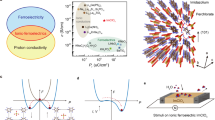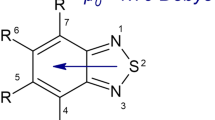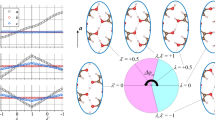Abstract
Molecular rotation has attracted much attention with respect to the development of artificial molecular motors, in an attempt to mimic the intelligent and useful functions of biological molecular motors. Random motion of molecular rotators—for example the 180∘ flip-flop motion of a rotatory unit—causes a rotation of the local structure. Here, we show that such motion is controllable using an external electric field and demonstrate how such molecular rotators can be used as polarization rotation units in ferroelectric molecules. In particular, m-fluoroanilinium forms a hydrogen-bonding assembly with dibenzo[18]crown-6, which was introduced as the counter cation of [Ni(dmit)2]− anions (dmit2−=2-thioxo-1,3-dithiole-4,5-dithiolate). The supramolecular rotator of m-fluoroanilinium exhibited dipole rotation by the application of an electric field, and the crystal showed a ferroelectric transition at 348 K. These findings will open up new strategies for ferroelectric molecules where a chemically designed dipole unit enables control of the nature of the ferroelectric transition temperature.
This is a preview of subscription content, access via your institution
Access options
Subscribe to this journal
Receive 12 print issues and online access
$259.00 per year
only $21.58 per issue
Buy this article
- Purchase on Springer Link
- Instant access to full article PDF
Prices may be subject to local taxes which are calculated during checkout




Similar content being viewed by others
References
Thomas, H. & Mueller, K. A. Structural Phase Transition I (Springer, 1981).
Lines, M. E. & Glass, A. M. Principles and Applications of Ferroelectrics and Related Materials 293–327 (Clarendon, 1977).
Johnson, R. D. et al. C60 rotation in the solid state: Dynamics of a faceted spherical top. Science 255, 1235–1238 (1992).
Stryer, L. Biochemistry 4th edn391–411 (Freeman, 1995).
Kelly, T. R., De Silva, H. & Silva, R. A. Unidirectional rotary motion in a molecular system. Nature 401, 150–152 (1999).
Koumura, N. et al. Light-driven monodirectional molecular rotor. Nature 401, 152–155 (1999).
Leigh, D. A., Wong, J. K. Y., Dehez, F. & Zerbetto, F. Unidirectional rotation in a mechanically interlocked molecular rotor. Nature 424, 174–179 (2003).
Kottas, G. S. et al. Artificial molecular rotors. Chem. Rev. 105, 1281–1376 (2005).
Kay, E. R., Leigh, D. A. & Zerbetto, F. Synthetic molecular motors and mechanical machines. Angew. Chem. Int. Ed. 46, 72–191 (2007).
Nakamura, T. et al. A molecular metal with ion-conducting channels. Nature 394, 159–160 (1998).
Akutagawa, T., Takeda, S., Hasegawa, T. & Nakamura, T. Proton-transfer and dielectric phase transition in molecular conductor (HDABCO+)2(TCNQ)3 . J. Am. Chem. Soc. 126, 291–294 (2004).
Sherwood, J. N. (ed.) The Plastically Crystalline State (Wiley, 1979).
Garcia-Garibay, M. A. Crystalline molecular machines: Encoding supramolecular dynamics into molecular structure. Proc. Natl Acad. Sci. 102, 10771–10776 (2005).
Horansky, R. D. et al. Dielectric response of a dipolar molecular rotor crystal. Phys. Rev. B 72, 014302 (2005).
Nishihara, S. et al. Multirotations of (anilinium+)([18]crown-6) supramolecular cation structure in magnetic [Ni(dmit)2]− salt. Chem. Asian J. 2, 1083–1090 (2007).
Sato, D. et al. Supramolecular rotor of adamantylammonium([18]crown-6) in [Ni(dmit)2]− salt. Inorg. Chem. 46, 363–365 (2007).
Akutagawa, T. et al. Solid state molecular rotators of anilinium and adamantylammonium in [Ni(dmit)2]− salts with diverse magnetic properties. Inorg. Chem. 47, 5951–5962 (2008).
Horiuchi, S. et al. Ferroelectricity near room temperature in co-crystals of nonpolar organic molecules. Nature Mater. 4, 163–166 (2005).
Katrusiak, A. & Szafrański, M. Ferroelectricity in NH–N hydrogen bonded crystals. Phys. Rev. Lett. 82, 576–579 (1999).
Horiuchi, S. & Tokura, Y. Organic ferroelectrics. Nature Mater. 7, 357–366 (2008).
Desiraju, G. R. & Steiner, T. The Weak Hydrogen Bond 122–292 (Oxford Univ. Press, 1999).
Kao, K. C. Dielectric Phenomena in Solids (Elsevier, 2004).
Acknowledgements
This work was supported in part by a Grant-in-Aid for Science Research from the Ministry of Education, Culture, Sports, Science, and Technology of Japan. We would like to thank J. Kawamata and H. Yamaki (Yamaguchi Univ.) for conducting the second harmonic generation measurements.
Author information
Authors and Affiliations
Contributions
T.A. and T.N. planned the project and carried out experimental work with the other authors. H.K., D.S. and S.-I.N. carried out sample preparation, structural analysis and electrical measurements. S.T. conducted measurements of temperature-dependent NMR spectra. R.K., H.T. and Y.T. carried out the synchrotron radiation X-ray crystal structural analysis at the High Energy Accelerator Research Organization.
Corresponding authors
Supplementary information
Supplementary Information
Supplementary Information (PDF 831 kb)
Rights and permissions
About this article
Cite this article
Akutagawa, T., Koshinaka, H., Sato, D. et al. Ferroelectricity and polarity control in solid-state flip-flop supramolecular rotators. Nature Mater 8, 342–347 (2009). https://doi.org/10.1038/nmat2377
Received:
Accepted:
Published:
Issue Date:
DOI: https://doi.org/10.1038/nmat2377
This article is cited by
-
Applications of macrocycle-based solid-state host–guest chemistry
Nature Reviews Chemistry (2023)
-
Superior ferroelectricity and nonlinear optical response in a hybrid germanium iodide hexagonal perovskite
Nature Communications (2023)
-
Direct observation of geometric and sliding ferroelectricity in an amphidynamic crystal
Nature Materials (2022)
-
Biferroelectricity of a homochiral organic molecule in both solid crystal and liquid crystal phases
Nature Communications (2022)
-
Half-Sandwich LaBn−/0 (n = 14–17): π Dually Aromatic Lanthanide Boride Complexes with Multicenter Fluxional Bonds
Journal of Cluster Science (2022)



